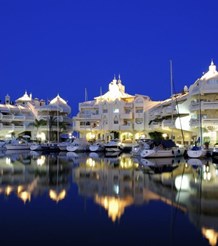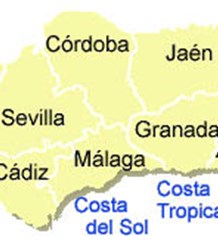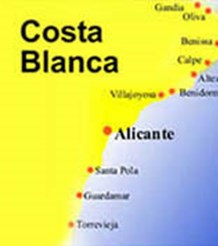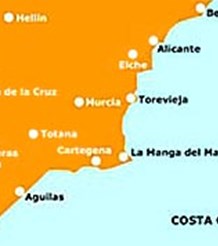Costa de la Luz Information
The 300km of coastline that makes up the Costa de la Luz is the most southerly point in mainland Spain. It is located on the Atlantic coastline and forms the western part of Andalucia. This costa is part of the provinces of Cadiz and Huelva, stretching from Punta de Tarifa, in the Straits of Gibraltar, to Ayamonte, on the border with Portugal. There are fabulous dune backed beaches of fine white sand, pinewoods and fishing villages and magical sunsets.
There are several nature reserves, which makes the area a nature lover and bird watcher’s paradise. La Janda, an area to the north west of Tarifa, is home to great numbers of wintering cranes. The whole area is populated with griffin vultures and eagles that glide on the warm thermals looking for food and white storks and egrets are a common sight. During the summer several species of rare butterflies can be found. Here, too, are many flowers and plants that are indigenous to this area of Spain.
As yet the Costa de la Luz has not succumbed to the mass tourism of the Costa del Sol, but it is becoming increasingly popular. Here house prices are much lower than on the neighbouring Costa del Sol,so properties are being snapped up.
Cádiz
The city Cádiz, one of the main Spanish ports, is on a peninsula that juts into the bay of the same name.
The Phoenicians who founded their trading post there in 1100 BC named it Gadir. Some of the city's 18th century walls, such as the Landward Gate, are still standing. The old city looks Moorish and has narrow cobbled streets that open into small squares.
The old quarter of Cádiz is famous for its picturesque charm, and many of the buildings reflect the city's overseas links. Worth a visit are the Cathedral and churches of Santa Cruz and San Felipe Neri. The latter is famous throughout Spain as the place where, in defiance of Napoleon's siege, the provisional government was set up with its own liberal constitution. Other points of interest are La Santa Cueva, home to several paintings by Goya, and stately mansions such as the Casa del Almirante and Casa de las Cadenas.
Tarifa
The position of Tarifa, at the southernmost tip of Europe where Europe is separated from Africa and the Mediterranean from the Atlantic, produces a unique microclimate. This is easily noted by the strong prevailing winds that keep the temperatures mild all year round.
These same winds have discouraged mass tourism and development. However with the new trend in holidays towards natural tourism, Tarifa with its virgin beaches and vast uncontaminated landscape is becoming more popular. Nearly every class of land and sea sport is available in Tarifa, but it is particularly noted for its great windsurfing, kite surfing and scuba diving.
You can travel from Tarifa to Africa in less than 15 kilometres (35 minutes by high speed ferry) and there are daily boat trips to Tangier, across the straits of Gibraltar.






